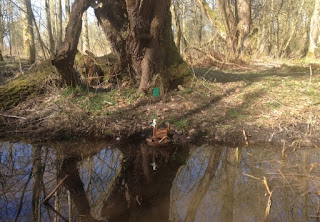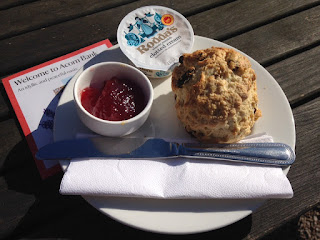I definitely recognised the name Ellen Terry before my trip to Smallhythe Place today. I just couldn't think who she was. I'm fairly sure I had a PE teacher called Ellen Terry, but although having to teach me PE should definitely have resulted in some kind of bravery award, I'm not sure it is of major significance to the National Trust.
Anyway, it turns out that Ellen Terry was a very famous Victorian actress. If her name had been Dottie Carmichael or Mabel Sweetroses, I would have got it right away.
Here are my five favourite things about Smallhythe Place:
1. The history of Ellen Terry:
There are hundreds of pictures and photographs of Ellen Terry around the house - she'd have given Kim Kardashian a run for her money.
I definitely recognised this picture of her - it's in the National Portrait Gallery and was painted by her first husband:
And I also recognised this one, painted by John Singer Sargeant - it's Ellen playing Lady Macbeth. This one is in the Tate Gallery:
4. The Costume Room
The costume in the picture above can be seen at Smallhythe Place. It's astounding. It's made of crochet and is covered in actual beetle wings from the green jewel beetle. It was recently restored and it looks amazing. Someone on Twitter asked me if she was putting up a light fitting and someone else asked me if I was at the National Smoke Alarm Museum, neither of which I can now get out of my head:
5. The theatre
There is an actual working theatre at Smallhythe - you can go and watch everything from Much Ado About Nothing to The Wizard Of Oz this summer - and many famous actors have acted there. I tried to resist saying "more cheese, Gromit?" when I saw the name Peter Sallis, but I failed. Anyway, it's a great little place. You can also hire it for events - I may well persuade Harvey Weinstein to hold the world premiere of National Trust Scones: The Movie here when the time inevitably comes.
The Smallhythe scone
But onto the scone. I've got to be honest: the Smallhythe scone looked and tasted shop-bought to me. The Scone Sidekick strongly disagreed with me here, and I have to admit; NOBODY in their right mind would charge £5.50 for a cream tea with a shop-bought scone, so it must have been home-made. It definitely wasn't fresh though.
However, it was quite tasty - it looked dry but it was actually quite chewy - and that's really all that matters.
It's one of my favourite things about the National Trust: you go along not knowing anything at all about a person and you come away fascinated by them (see also: Cherryburn).
Smallhythe: 4.5 out of 5
Scones: 3.5 out of 5
The tablecloths in the tearoom: 5 out of 5
Here are my five favourite things about Smallhythe Place:
1. The history of Ellen Terry:
- She was born in Coventry in 1847
- Her parents were 'circuit players' - actors that moved from town to town
- Ellen started acting in 1856, playing Mamillius in The Winter's Tale
- At 16, she and her older sister Kate were appearing in London theatres - Kate was eventually the grandmother of Sir John Gielgud, factoid fans
- The artist GF Watts painted Ellen and Kate, and Ellen married him when he was 46 and she was 17
- They separated within a year - he said he couldn't live with her
- She went back to her parents and to acting
- She then took up with Edward Godwin, the architect, with whom she had two children, Edith and Edward
- Times got hard and Ellen returned to the stage again
- She parted from Godwin and married Charles Wardell, an actor
- In the same year (1878), she began a very successful acting partnership with Henry Irving at the Lyceum theatre, where they alternated between Shakespeare and popular melodrama
- After 20 years, the Lyceum also hit hard times and Ellen leased the Imperial Theatre but it wasn't successful
- She secretly married an American actor called James Carew (Charles had died)
- She started lecturing on Shakespearean heroines when she finished acting
- She had a stroke and died in 1928
There's a lovely story in the guidebook of how Ellen came to own Smallhythe. She first saw it in the late 1890s when she was driving around Rye and Tenterden in Kent with Henry Irving. She asked the old shepherd living in the house to tell her when he was ready to sell. In 1899 a postcard duly arrived with the three words 'House for Sale' on it and that was it - Ellen bought the place.
2. The house at Smallhythe:
- It was built in the first half of the 16th century
- It was the Port House to the shipyard - the river Rother used to be navigable as far as Smallhythe before the water receded
- Ellen spent as much time as she could at Smallhythe between 1899 and 1928
- Her daughter Edith (or Edy) lived at the Priest's House, one of the cottages next to Smallhythe Place
- Edy lived in a menage a trois with two other women - Vita Sackville West from nearby Sissinghurst used to call them "the old trouts"
- When Ellen died, Edy set about making Smallhythe a shrine to her mother - she created the Costume Room and filled other rooms with theatrical relics
- The National Trust took over in 1939
There are hundreds of pictures and photographs of Ellen Terry around the house - she'd have given Kim Kardashian a run for her money.
I definitely recognised this picture of her - it's in the National Portrait Gallery and was painted by her first husband:
And I also recognised this one, painted by John Singer Sargeant - it's Ellen playing Lady Macbeth. This one is in the Tate Gallery:
4. The Costume Room
The costume in the picture above can be seen at Smallhythe Place. It's astounding. It's made of crochet and is covered in actual beetle wings from the green jewel beetle. It was recently restored and it looks amazing. Someone on Twitter asked me if she was putting up a light fitting and someone else asked me if I was at the National Smoke Alarm Museum, neither of which I can now get out of my head:
5. The theatre
There is an actual working theatre at Smallhythe - you can go and watch everything from Much Ado About Nothing to The Wizard Of Oz this summer - and many famous actors have acted there. I tried to resist saying "more cheese, Gromit?" when I saw the name Peter Sallis, but I failed. Anyway, it's a great little place. You can also hire it for events - I may well persuade Harvey Weinstein to hold the world premiere of National Trust Scones: The Movie here when the time inevitably comes.
The Smallhythe scone
But onto the scone. I've got to be honest: the Smallhythe scone looked and tasted shop-bought to me. The Scone Sidekick strongly disagreed with me here, and I have to admit; NOBODY in their right mind would charge £5.50 for a cream tea with a shop-bought scone, so it must have been home-made. It definitely wasn't fresh though.
However, it was quite tasty - it looked dry but it was actually quite chewy - and that's really all that matters.
It's one of my favourite things about the National Trust: you go along not knowing anything at all about a person and you come away fascinated by them (see also: Cherryburn).
Smallhythe: 4.5 out of 5
Scones: 3.5 out of 5
The tablecloths in the tearoom: 5 out of 5






















